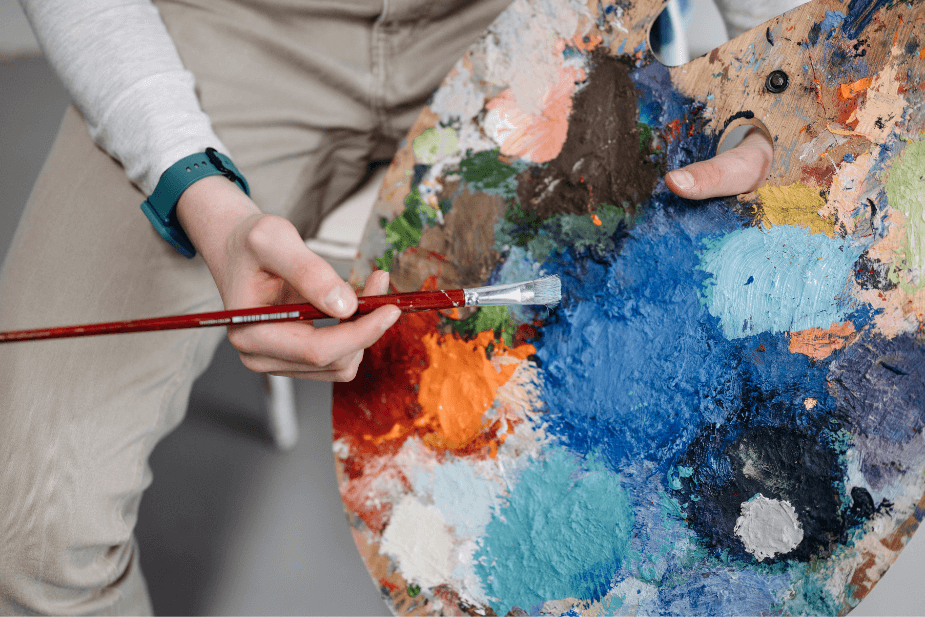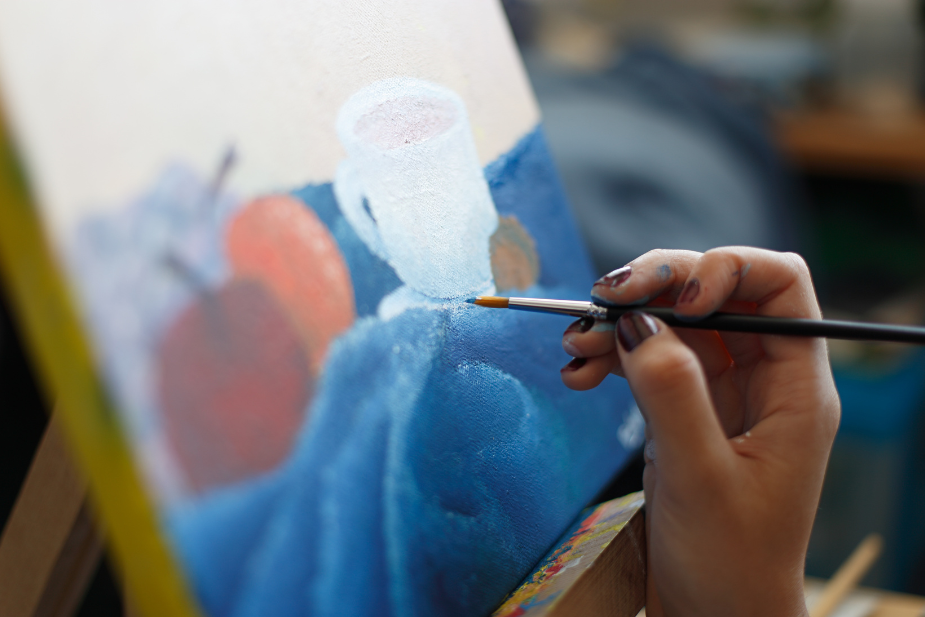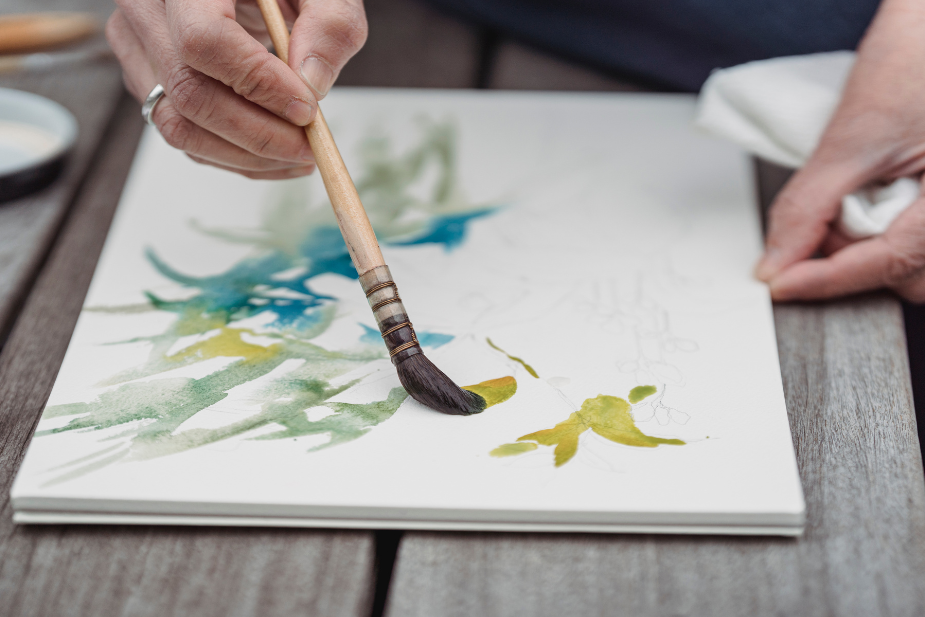
Oil Painting
Oil paint is a slow-drying medium consisting of pigments suspended in a drying oil, usually linseed oil, which acts as a binder. Other nut and plant-based oils such as hemp, sunflower, safflower, poppy, walnut and synthetic variants are also used. The type of oil changes the properties of the paint and affects, for example, the clarity of light colours, whether yellowing of the work occurs and the drying time of the individual colour.
Whichever oil is chosen as the binder, the purpose will be the same: for the oil paint to start drying and hardening as soon as it comes into contact with oxygen. For this reason, these binders are called oxidatively curing oils, which is the scientific name for this process. This is in contrast to acrylic and watercolour paints, where the water in these evaporates instead.
In addition, some manufacturers choose to add additives that can further affect the properties of the paint; typically changing drying time, resistance to UV rays or the amount of gloss in the paint.
However, many oil painters still prefer the traditional oil paints based on cold-pressed vegetable and nut oils and without altered properties. This may be an expression of conservatism and tradition, but it is also a question of the fact that, for example, the so-called siccatives added to speed up the drying time may damage the stability and durability of the work over time.
The viscosity (toughness) of oil paint can be altered by the addition of solvents such as artist-grade mineral turpentine or other thinners. This gives the oil paint enormous flexibility, as it can be used for everything from very thin and semi-transparent layers, so-called glazes, to a thick paste that can "stand up" on the canvas as we know it from the impasto technique.
Starting with oil paints can be a bit of a hassle and, financially speaking, it is also a major investment in the start-up phase, as you will need at least a canvas, paints and brushes and, ideally, a painting stick, a palette and an easel on which to stretch the canvas.
At Stelling we have products in all price ranges for each of these categories, as well as offering guidance to get you started easily.
Here is a short list of advice for beginners that we think will help most people:
- If you want an affordable product, you might want to buy oil paints from Georgian - you'll get good quality at a cheap price.
- Don't skimp on brushes, but instead buy a few high-quality ones like this set of pig hair brushes from Da Vinci and take good care of them.
- An easel is a good investment from the start, as it's ergonomic and practical and can take you from beginner to expert. We recommend this [insert link] from [insert manufacturer].
- Buy good quality canvases, such as Stelling's hand-stretched canvases.
Special features
"Fat over skinny" is an expression you may have heard. The rule allows you to create a work where the paint is more elastic and flexible, leading to less or no crazing.
The principle of the rule is that the work is built up in layers, with each layer being "fatter" than the one underneath. "Fatter" in this context means that the given layer of paint has a higher oil content relative to the ratio of pigment than the layer it is intended to cover. This can be achieved by two methods:
First approach involves adding a alkydFirst, you add an alkyd, usually turpentine, in equal amounts to all the paint you need for the work. During the process, the oil content is adjusted as you move up the layers. This can be done by adding additional hardening oil or a medium such as Gamsol.
The second approach skips the step where the mixture is first made "lean" and instead focuses on making each new layer richer than the one underneath, but the principle is the same: that a more oily layer covers a smaller one.
Another well-known characteristic is the long drying time of the medium and specifically what possibilities this gives to the artist.
It is important for us here at Stelling to mention that the drying time of oil paint is often exaggerated and depends primarily on the thickness of the layer. If you work in fine, thin layers you will often have completely dry layers within 24 hours - even without the use of media, but it is true that techniques such as impasto or "puddling", where very thick layers are worked in, can lead to drying times that in extreme cases can take months.
The period during which a layer is curing can be used to adjust the tone of colours, correct mistakes or even remove whole layers. Some artists choose to embrace the long drying time fully and work only wet-on-wet, a technique you may know as alla prima.
This leads to an interesting flexibility in oil painting, where works can take months or even years to complete while other works, such as those done entirely wet-on-wet, can be completed in a single painting session.
The story behind
The first use of oil paint goes back a long way. Archaeological evidence from Asia suggests that oil paint has been used in art since 650 AD, and possibly even further back.
As well as being used in art, oil paint has been used throughout history to paint everything from insignia on shields to protecting woodwork.
In our culture, it was during the Renaissance that the use of oil paint as an art medium became predominant, as the long drying time and other properties of oil paint allowed for new techniques as well as greater detail and precision.
Throughout the early history of oil painting, mixing the right amount of finely grated pigment with binder was a matter of course - and an art in itself, but this changed from 1841 when the American John Goffe Rand, himself an artist, invented oil paint in tubes. This invention benefits us today, but as well as being practical and economical, it made possible, among other things plein air-outdoor use, mass production of oil paint and much greater spontaneity across all disciplines.
Classifications
Artist
"Artist" is each producer's most exclusive and most expensive grade of oil paint. The quality is characterised by enormously high reliability - both in terms of stability and durability - as well as how colourfast it is. In addition, the Artist series contains an enormously high amount of colour pigments and some absolutely fantastic binders.
This gives a very impactful effect, so you will often "tone down" your Artist oil paint by diluting with mineral turpentine and/or another medium and mixing it with other colours, but you also have the opportunity to create works with an explosion of dynamic and intense colours by using the product straight from the tube.
Another advantage of Artist is that you don't have to worry when mixing two or more colours. This helps to distinguish Artist quality from Studio, where certain very expensive pigments are replaced by cheaper ones and so-called "hues" are created. These resemble the desired pigment well enough, but can give altered results when mixing colours.
In the Artist ranges, products will typically be priced according to how expensive the individual colour pigment may be. Therefore, you will often see certain yellows, reds and blues being quite a bit more expensive than earth tones and white and black, for example.
Studio
"Studio", or "student" as it is also sometimes known, is a cheaper grade classification than "Artist" and the common wisdom is that these affordable alternatives can be used when creating studio works and/or in learning situations where a lot of oil paint needs to be flung onto a canvas in a hurry and it would be too costly to use Artist.
So, although a cheaper product with fewer pigments and a less good binder, you can easily use these series for your finished works - even as a professional artist. It is just important to be aware that the quality is different and lower.
As is the case with the "big brother", not all pigments are born equal. You will therefore sometimes find that products in the Studio ranges have a different amount of colour pigment in them, as well as selected colours not being available in Studio quality at all, as the pigments are simply too expensive for a more affordable range. These exotic or rare colour pigments are replaced by cheaper alternatives - so-called hues, which are confusingly similar but in some cases have altered properties due to the choice of pigments from other pigment families.
Variants
Water-soluble oil paints have been developed specifically to behave like the classic oil paint. The difference is its ability to be diluted with water, which also has implications for cleaning brushes, palette and work area. Harmful solvents are therefore not needed for water soluble oil paint and artists can enjoy a safer working environment, making water soluble oil paint ideal for artists who share studio space, or paint at home. An example of a great water soluble oil paint is Artisan line from Winsor & Newton.
Why choose oil paints over acrylics
Acrylic paint is a modern paint created in many ways as an antidote to perceived difficulties with oil paint.
One advantage of acrylic paint that is often highlighted is its fast drying time, but depending on the artist's temperament and working approach, this can be a negative; indeed, very long drying times allow for the correction of mistakes, the adjustment of tones and even the removal of entire layers of paint. The distance between the drying times of the two media can be adjusted through a variety of media and specially designed product lines. For example, in Stelling you can buy Open from GOLDEN, which is specifically formulated to have exceptionally long drying time for an acrylic paint.
In the past, a clear reason for preferring acrylic paint was that it is simply a safer medium, but let's not forget that oil paint in modern times is a very different medium than it was historically. The extremely toxic and dangerous pigments such as copper arsenite acetate, an insecticide and rat poison that was used as a pigment in the colour Schweinfurter green (also known as Paris green) are no longer used. The solvents used today have also improved and there are even water-soluble oil paints.
Over time, acrylic paints have been developed that are better suited to wet-on-wet techniques, but there is no doubt that the technique is best suited to the oil medium. On the one hand, you don't have to do anything to the oil paint to work wet-on-wet, but you can also work in thick layers, where the acrylic paint is typically thinned quite a bit to extend its drying time.
Oil painting, moreover, is a medium so well-studied and familiar that there are very, very few unknowns: we know how works age, we know how the great masters have prepared their works, and you, as a newly minted oil painter, are therefore entering a rich, fantastic tradition that simply does not yet exist in acrylic painting.
Why choose oil painting over watercolour
The obvious advantage of oil paint is its flexibility in terms of consistency and specifically what this means for the medium's covering power; for you can create thin and fine semi-transparent layers or thick, heavy ones with full covering power, creating a surface that can be perfectly smooth and without a trace of the brush or well-textured and proudly bearing the scars of each brushstroke; oil paint can it all and then some.
Both mediums lend themselves to wet-on-wet techniques, but in general and very broadly speaking, oil paint requires less finesse. Watercolour also tends to behave unpredictably with this technique, and much of the artist's skill is therefore about the ability to anticipate as well as work within this unpredictability. If you are a beginner, this characteristic of watercolours can be frustrating, so it may be worth opting for oil paints if you would like to try your hand at this form of work.
If you enjoy both mediums, a good option might be to do studies in watercolour and then finish your work in oil paint. This method has been historically relevant to many artists, but 19th century American artists in particular saw the strength in this approach.



